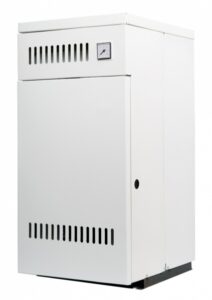The energy efficiency of natural gas furnaces continues to improve as technology advances. Once, standard furnaces had an AFUE rating of 70, which means the furnace would convert 70% of its fuel source (natural gas) into direct heat, losing 30% to exhaust. Today, many standard furnaces have 85 AFUE, and special high-efficiency furnaces can score in the high 90s. That’s an enormous change in efficiency that can mean significant savings for a household over the winter.
If you’re considering a new furnace installation in Ellensburg, WA or elsewhere in our service area, we recommend you look into high-efficiency furnace models. They cost more than mid-efficiency furnaces, but the long-term savings will help these furnaces pay for themselves in a few years.
If you’re curious about what allows high-efficiency furnaces to use so much less power to do the same job, follow us below.
Condensing Technology
This is the most important development for high-efficiency furnaces. A mid-efficiency furnace extracts heat from combustion gas through a chamber called the heat exchanger. When the combustion gas cools, the remaining exhaust exits through a flue. In a condensing furnace, there’s a second heat exchanger—the exhaust goes to this exchanger where it’s condensed, drawing even more heat out of it. It’s an extra “squeeze” on the natural gas that gets the maximum amount of thermal energy out of it.
Variable Speed Blower Motors
The invention of inverter motors has improved the performance of numerous devices. Inverter motors can alter the speed at which they run so they don’t always run at capacity. The variable speed motor that powers the blower in a high-efficiency furnace slows down as necessary so it doesn’t have to use as much power. This also helps the furnace avoid temperature fluctuations.
Modulating Burners
These burners are similar to variable speed motors: unlike the burners in mid-efficiency furnaces, which only operate at a fixed capacity, modulating burners will adjust the flame size and heat output based on temperature requirements, creating a more precise and efficient heating process.
Sealed Combustion
Sealed combustion keeps the combustion process inside a sealed chamber. Rather than draw air from the house, it draws air from outside the home through a PVC tube. This process is more efficient because there’s less heat loss during combustion. Sealed combustion also prevents the mixing of indoor and outdoor air, which is a common source of homes becoming too dry when the furnace is running.
Electronic Ignition Systems
The old standing pilot light is now a thing of the past. Rather than letting a pilot light burn throughout the winter and drain natural gas, an electronic ignition system takes care of lighting the burner as needed.
Insulated Heat Exchangers
The heat exchangers in high-efficiency furnaces have better insulation so they don’t lose their heat as rapidly and maximize the amount of heat transferred to the air.
If you have any questions about high-efficiency furnaces, we are happy to answer them. We’ll help you find the right heating system for your needs.
Call ThermAll Heating & Cooling, Inc for all your furnace needs in Yakima, Ellensburg, Cle Elum, and the surrounding areas. We are “Your Home Comfort Hero!”

